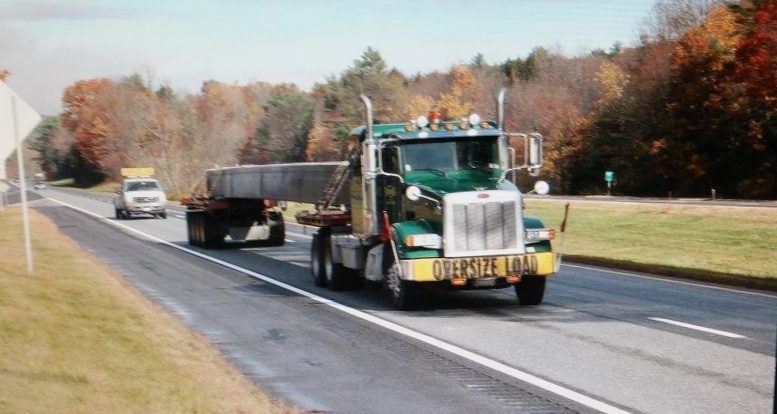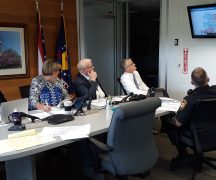By JAN LARSON McLAUGHLIN
BG Independent News
Wood County officials tired of roads being beat up by overweight trucks may start using portable scales to snag those heavy loads.
Wood County Engineer John Musteric and Wood County Sheriff Mark Wasylyshyn made a pitch to the county commissioners Thursday morning about setting up an overweight vehicle permit program using scales that can easily be transported throughout the county.
The goal isn’t to make money off of permits and fines, Musteric said, but rather to discourage heavy trucks from breaking up county roads.
Overweight truck traffic is increasing on interstates, so it’s only natural that to reach their destinations, those trucks have to use smaller county and township roads. While most trucking companies get permits with ODOT for overweight loads, they often neglect to get permits at the local level, Musteric said.
Last year, Ohio issued 367,332 permits for overweight trucks. When detailing their routes, those trucking companies identified 46,034 loads that traveled through Wood County. Yet only 57 permits were issues for Wood County, Musteric said.
The legal limit on Ohio roads is 80,000 pounds. Some of the heavy trucks weigh as much as 165,000 pounds.
“Some of those people aren’t going to be happy,” Wasylyshyn said.
Permits can be purchased per truck, per route traveled.
“If they get off that route, and they get nailed, they pay hefty fines,” Musteric said.
But Musteric stressed the goal isn’t to make money, but to control which roads overweight trucks travel. “Believe me, this is not a money grab for us,” he told the commissioners.
The county’s roads and bridges are in “dire straits” and suffer from heavy loads. So part of the permitting program will be educational – with efforts made to direct overweight traffic to more suitable routes.
The sheriff and engineer suggested that Wood County use portable scales as part of that educational process.
“ODOT has three portable scales just waiting to be used, at no cost,” Musteric said.
Construction of the Rover pipeline across southern Wood County has taught the engineer’s office a painful lesson, Musteric said.
“Rover tore the heck out of the roads,” the engineer said.
Signs have already been posted to keep Nexus pipeline construction trucks on roads that are better able to handle the heavy loads.
“They better stay on those routes. They’ve been warned,” Musteric said. “If you get off those routes, you will pay.”
A sheriff’s deputy could be trained to use the scales, which can handle trucks with up to 15 axles.
The sheriff’s office gets complaints about trucks suspected of carrying heavy loads. A dump truck heaped high with stone is likely too heavy for local roads, Wasylyshyn said.
“You can pretty much guarantee that truck is overweight,” he said.
But without scales, his deputies can’t prove the truck is in violation.
“I do get a lot of complaints about overweight trucks,” Wasylyshyn said. “But there’s very little I can do.”
The sheriff also has safety concerns, since trucks designed to handle 80,000 pounds, but carrying 160,000 pounds, cannot stop or make turns as expected.
Trucks under the 80,000 pound weight limit will not need to buy permits. And there is a 7.5 percent leeway allowed for farm trucks.
“The whole idea is to educate our drivers,” Wasylyshyn said. “It’s not like we’re out looking to write tickets.”
“Our goal is to get compliance,” he said. “We want to direct them off the 100-year-old bridge.”
The average overweight load permit is $150. The fines for not having a permit vary, but can be as high as $1,000. Wood County will set its fees.
“We don’t want to put anybody out of business,” Musteric said.
Commissioner Doris Herringshaw asked how the county can dispel rumors that the permitting program will target certain professions, like pipeline construction or farming. Musteric stressed the program will be enforced fairly for all traffic.
Initially, the program will be conducted on a part-time basis, using a deputy already with the sheriff’s office.
“I’m convinced we could keep someone busy full-time,” but the program will start small, Wasylyshyn said.
Next Thursday at 10 a.m., Musteric will be back to talk with the county commissioners about adding a $5 permissive license tax to help fund road and bridge work.
Earlier this week, the engineer reported on the dismal state of the county’s 245 miles of roads plus 441 bridges with an average age of 41 years.
Nearly three-quarters of the county’s roads are rated marginal or lower. Nearly half of those are ranked as poor or serious. Bringing those roads up to fair condition would cost an estimated $39 million.
Musteric mentioned the overweight trucks. “Some of them are twice the legal loads,” he said. “It’s kind of silly to spend all this money to fix our roads and bridges and find out they are being driven over by overweight vehicles.”
The lifespan of average pavement is 25 years. To catch up, the county would need to pave 35 miles every year – costing about $10.3 million each year. Instead, the county is spending about $1.1 million a year on paving.
When it comes to bridges, the county plans to replace four this year, costing about $1.2 million. More than half of the county’s bridges are over 50 years old, and 52 bridges are ranked in poor or worse shape. The cost to replace those 52 would add up to $20.8 million, Musteric said.
The county engineer’s office gets funding from the state gas tax, license plate fees and a smaller portion from traffic fines.
“It’s just a struggle because the gas tax hasn’t been raised,” Musteric said about the state tax stuck back at the 2006 level. “We’re at their mercy.”





